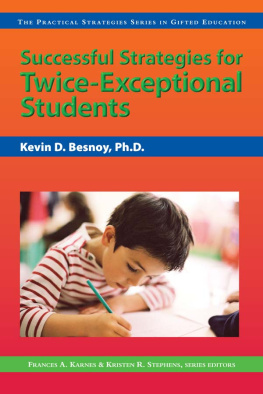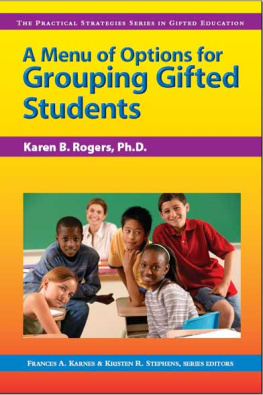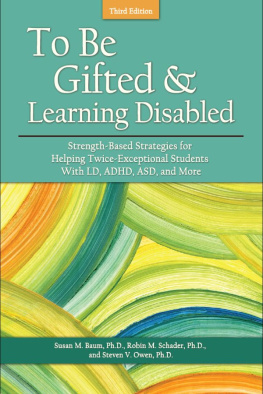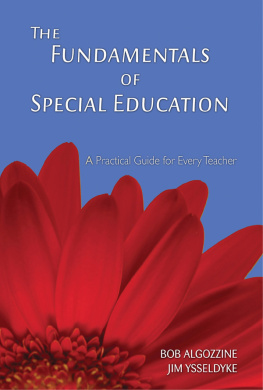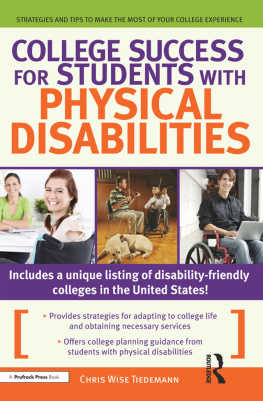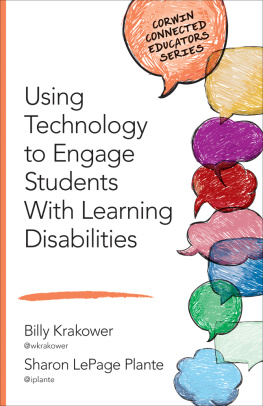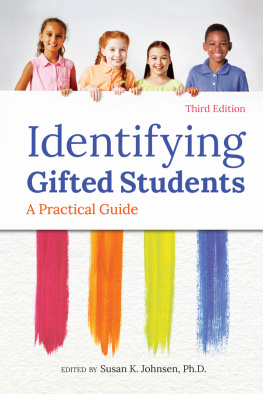THE PRACTICAL STRATEGIES SERIES
IN GIFTED EDUCATION
series editors
FRANCES A. KARNES & KRISTEN R. STEPHENS
Successful Strategies for
Twice-Exceptional Students
Kevin D. Besnoy, Ph.D.

P RUFROCK P RESS , I NC
Copyright 2006 by Prufrock Press Inc.
All rights reserved.
No part of this book may be reproduced, translated, stored in a retrieval system, or transmitted, in any form or by any means, electronic, mechanical, photocopying, microfilming, recording, or otherwise, without written permission from the publisher.
Printed in the United States of America.
ISBN-13: 978-1-59363-759-0
At the time of this books publication, all facts and figures cited are the most current available. All telephone numbers, addresses, and Web site URLs are accurate and active. All publications, organizations, Web sites, and other resources exist as described in the book, and all have been verified. The authors and Prufrock Press, Inc., make no warranty or guarantee concerning the information and materials given out by organizations or content found at Web sites, and we are not responsible for any changes that occur after this books publication. If you find an error, please contact Prufrock Press, Inc. We strongly recommend to parents, teachers, and other adults that you monitor childrens use of the Internet.

Prufrock Press, Inc.
P.O. Box 8813
Waco, Texas 76714-8813
(800) 998-2208
Fax (800) 240-0333
http://www.prufrock.com
Contents
General Characteristics of Gifted Students
With Learning Disabilities
Practical Strategies for Gifted Students
With a Mathematics Disability
Practical Strategies for Gifted Students
With Writing Disabilities
Series Preface
The Practical Strategies Series in Gifted Education offers teachers, counselors, administrators, parents, and other interested parties up-to-date instructional techniques and information on a variety of issues pertinent to the field of gifted education. Each guide addresses a focused topic and is written by scholars with authority on the issue. Several guides have been published. Among the titles are:
Acceleration Strategies for Teaching Gifted Learners
Curriculum Compacting: An Easy Start to Differentiating for High-Potential Students
Enrichment Opportunities for Gifted Learners
Independent Study for Gifted Learners
Motivating Gifted Students
Questioning Strategies for Teaching the Gifted
Social & Emotional Teaching Strategies
Using Media & Technology With Gifted Learners
For a current listing of available guides within the series, please contact Prufrock Press at (800) 998-2208 or visit http:// www.prufrock.com.
Introduction
As a young child, Frank W. Woolworth struggled in school. He had a difficult time keeping up with his classmates, and his teachers labeled him as slow. Although he was not very successful in school, young Frank experienced a lot of success in the business world. In order to help his family, he began working in a local grocery store where he helped market products. His idea was to place 5-cent items near the checkout counter. Although this may not seem like an innovative idea today, it was revolutionary at the time. Frank Woolworth did not allow his slow label to prevent him from becoming a successful businessman. In 1879, he opened his first store in Utica, NY. By 1911, the F. W. Woolworth Company had more than 1,000 stores across the United States and in other countries. The success of F. W. Woolworth demonstrates that gifted students with learning disabilities can be successful. Yet, if twice-exceptional students are to maximize their potential, they need appropriate instructional strategies that enable them to utilize their strengths to compensate for their disabilities.
Overview
Although it is difficult to comprehend, it is possible for a child to be both gifted and learning disabled. Everyone with a vested interest in the well-being of gifted and learning disabled students must be committed to providing them with an appropriate education. To meet this goal, we must first understand how the gift and disability manifest themselves.
In order to provide proper instructional strategies for gifted students with learning disabilities, it is necessary to understand their learning and social-emotional characteristics. In order for twice-exceptional children to maximize their potential, teachers, parents, and students must work together. Intervention strategies must boost self-efficacy, promote areas of strength, and provide coping strategies to compensate for disabilities.
Hannah and Shore (1995) assert that gifted students with learning disabilities are stereotyped. Their giftedness implies that they have metacognitive prowess, yet their learning disability suggests they lack strong metacognitive skills. These opposing stereotypes make it difficult to adequately define the characteristics of twice-exceptional students. Susan Baum (1990) groups twice-exceptional students into one of three categories: those who have been identified as gifted, but whose learning disability is not recognized; those who have an identified learning disability, but whose giftedness is unknown; and those whose giftedness and learning disability go unnoticed, thus they appear to be average students.
Identified Gifted
Gifted students with slight learning disabilities tend to be easily identified. Baum (1990) acknowledges that this group scores high on achievement and IQ tests, allowing educators to readily identify them as gifted. However, this group has a propensity to be underachievers and, as they progress through school, this underachievement intensifies. Baum suggests that such underachievement can be attributed to poor self-concept or lack of motivation. Moreover, Vaidya (1993) indicates that students with learning disabilities find learning a difficult and painful process. As these students matriculate through school, they become more frustrated with the learning process, thus the disparity between potential and achievement widens. These students tend to have poor handwriting and spelling skills (Fetzer, 2000); have high verbal abilities (Little, 2001); and are forgetful, sloppy, and disorganized (Baum). Often, teachers and parents, knowing the potential these students have, become frustrated with the students progress. According to Baum, concerned adults often believe these students only need to try harder in order to meet their potential. However, without appropriate intervention programs, increased effort is still not enough to generate achievement.
Brody and Mills (1997) note that these students learning disabilities may go unrecognized for the majority of their education. This oversight is a real concern for these students because they do not have the necessary skills to capitalize on their talent. According to Baum (1990), although increased effort may be required for achievement, the real issue is how these students compensate for their disability. By identifying the disability, educators can teach twice-exceptional students appropriate social and educational coping skills.
Identified Learning Disabled
The second group of twice-exceptional students is the identified learning-disabled students whose giftedness remains unrecognized. Fetzer (2000) reports that these students are frequently placed in classes for students with learning disabilities. Generally speaking, they are usually well-behaved. Interest-ingly, their disabilities tend to depress their intellectual performance, and they are rarely referred for gifted services (Brody & Mills, 1997). The services these students receive merely address their disability. Baum (1990) states that parents and teachers become focused on the problem because they do not recognize the students gifts. While these children often have high-level interests at home, little consideration is paid to their strengths and interests in school.
Next page
